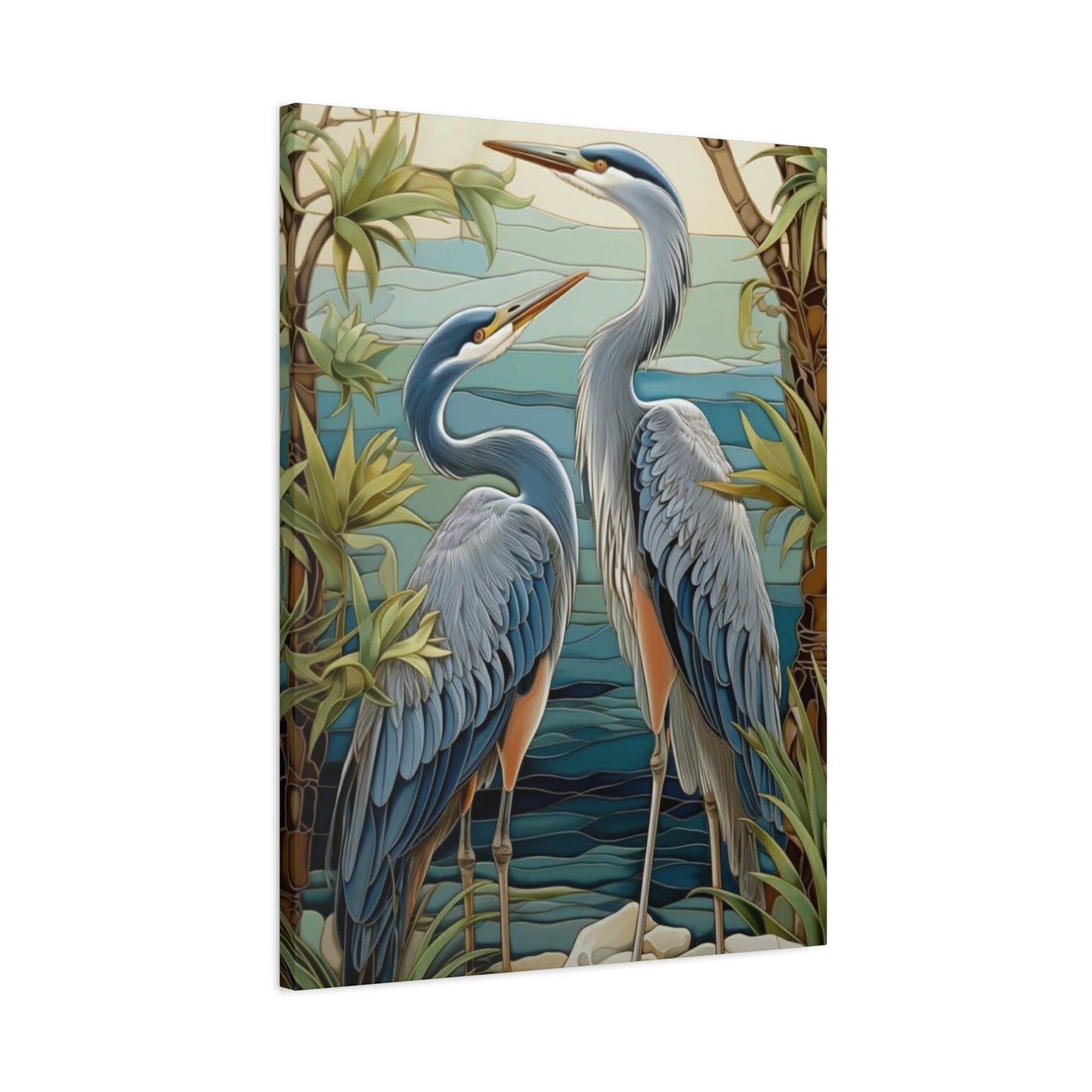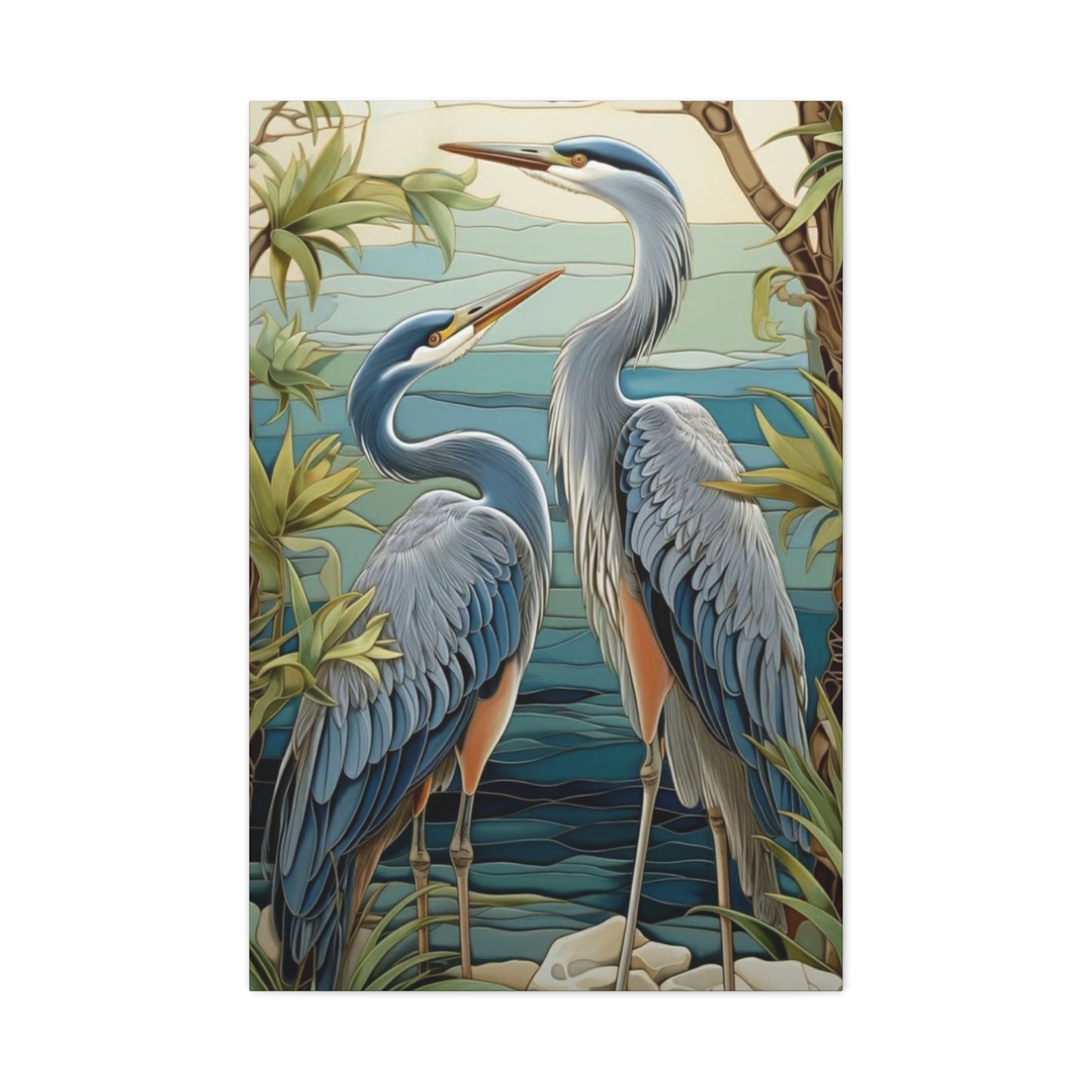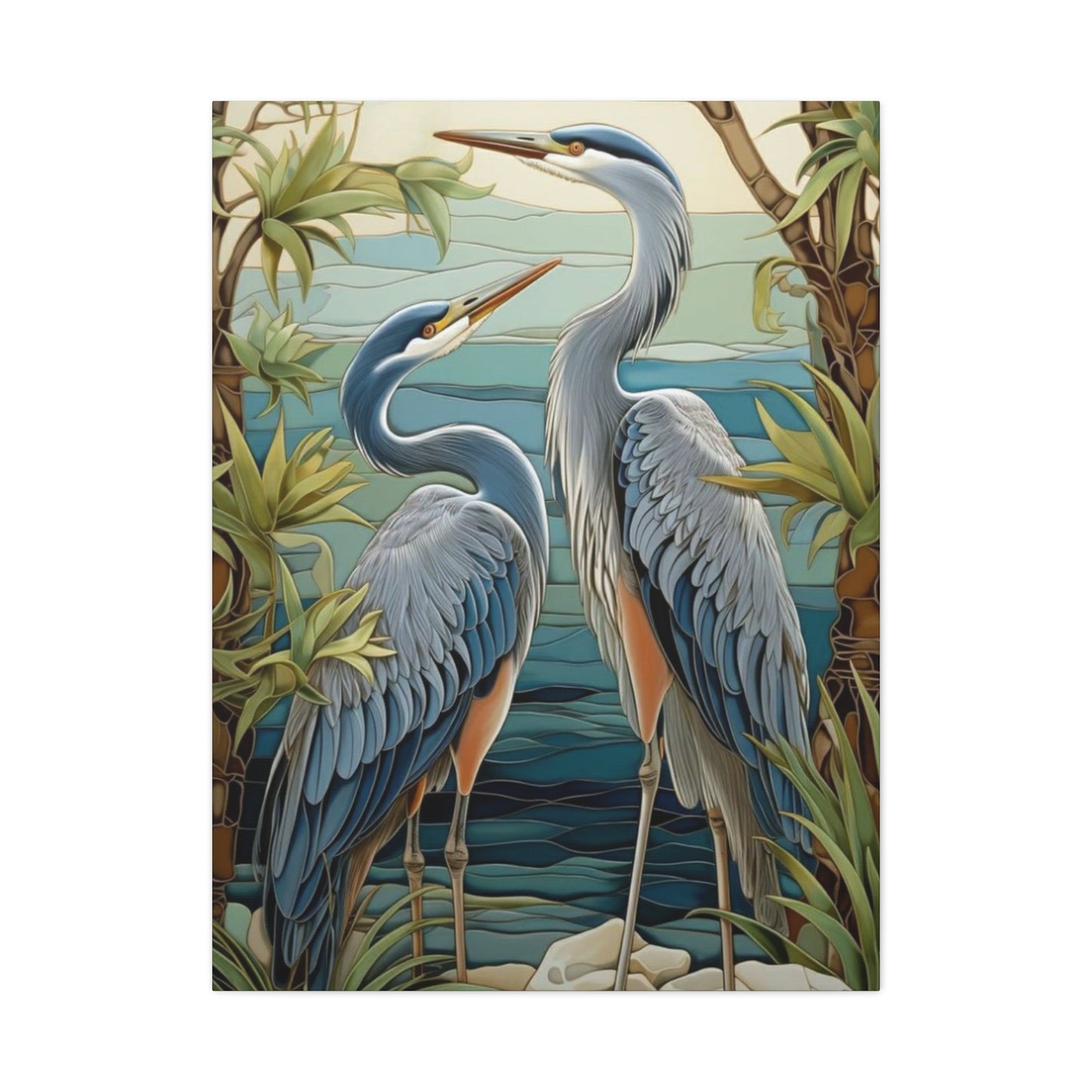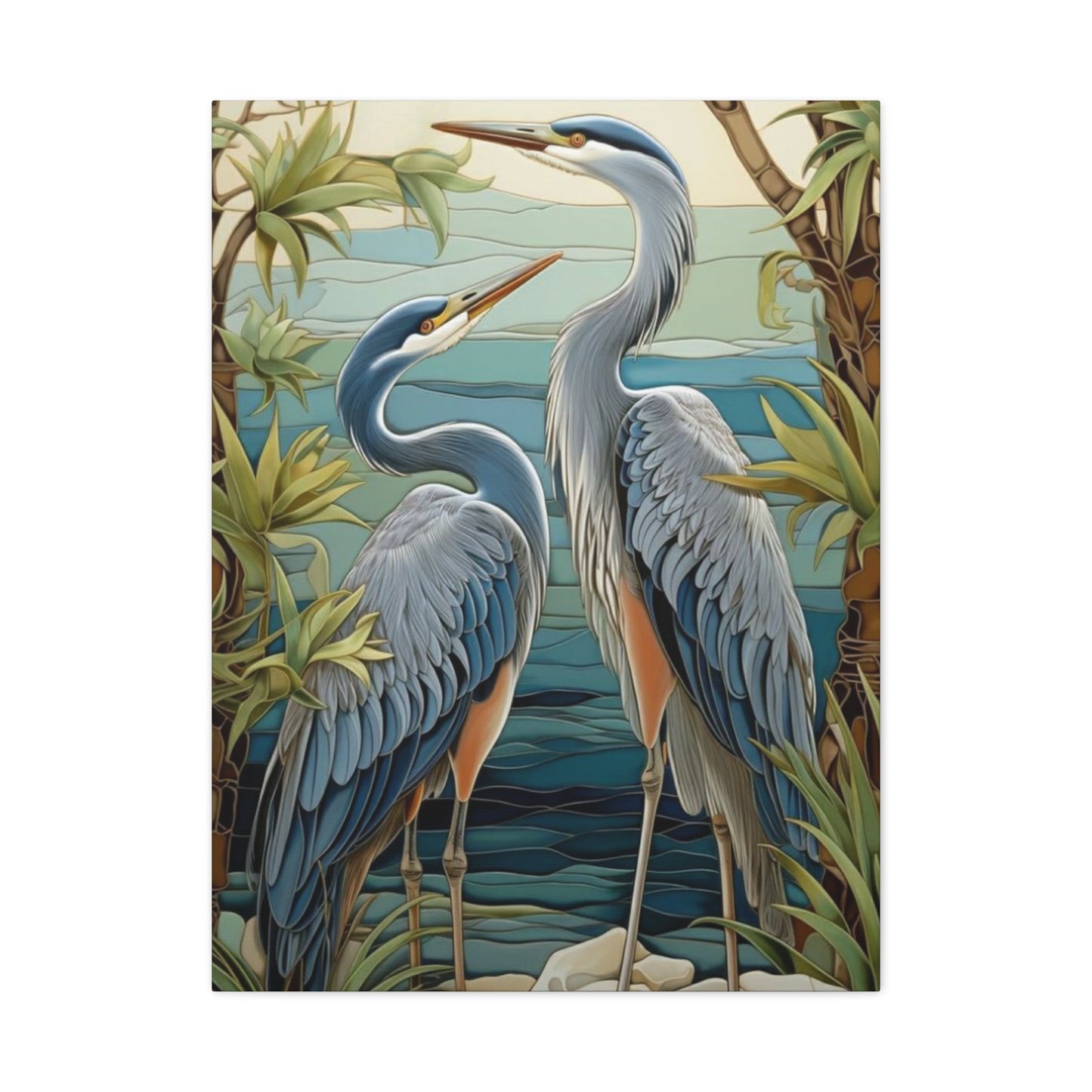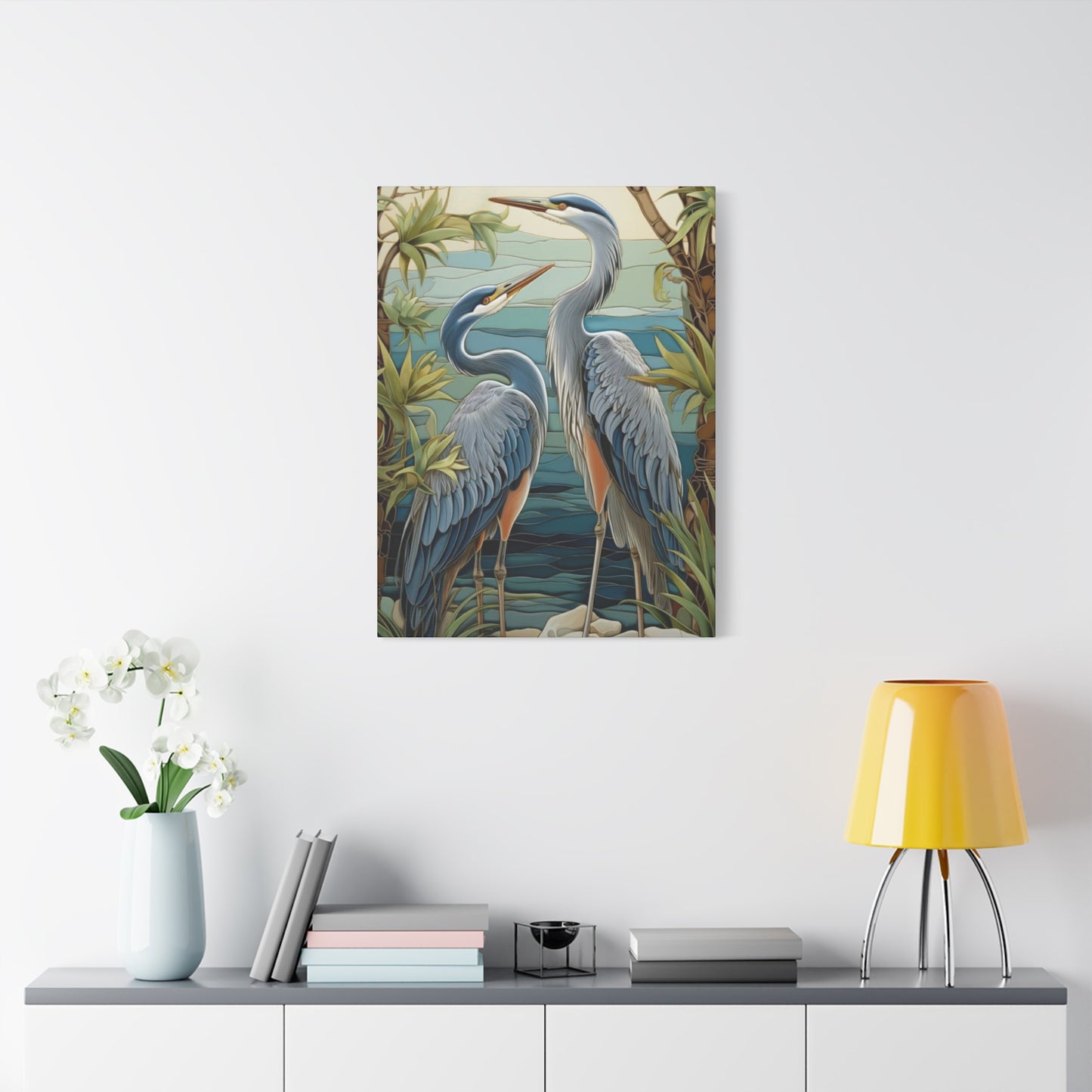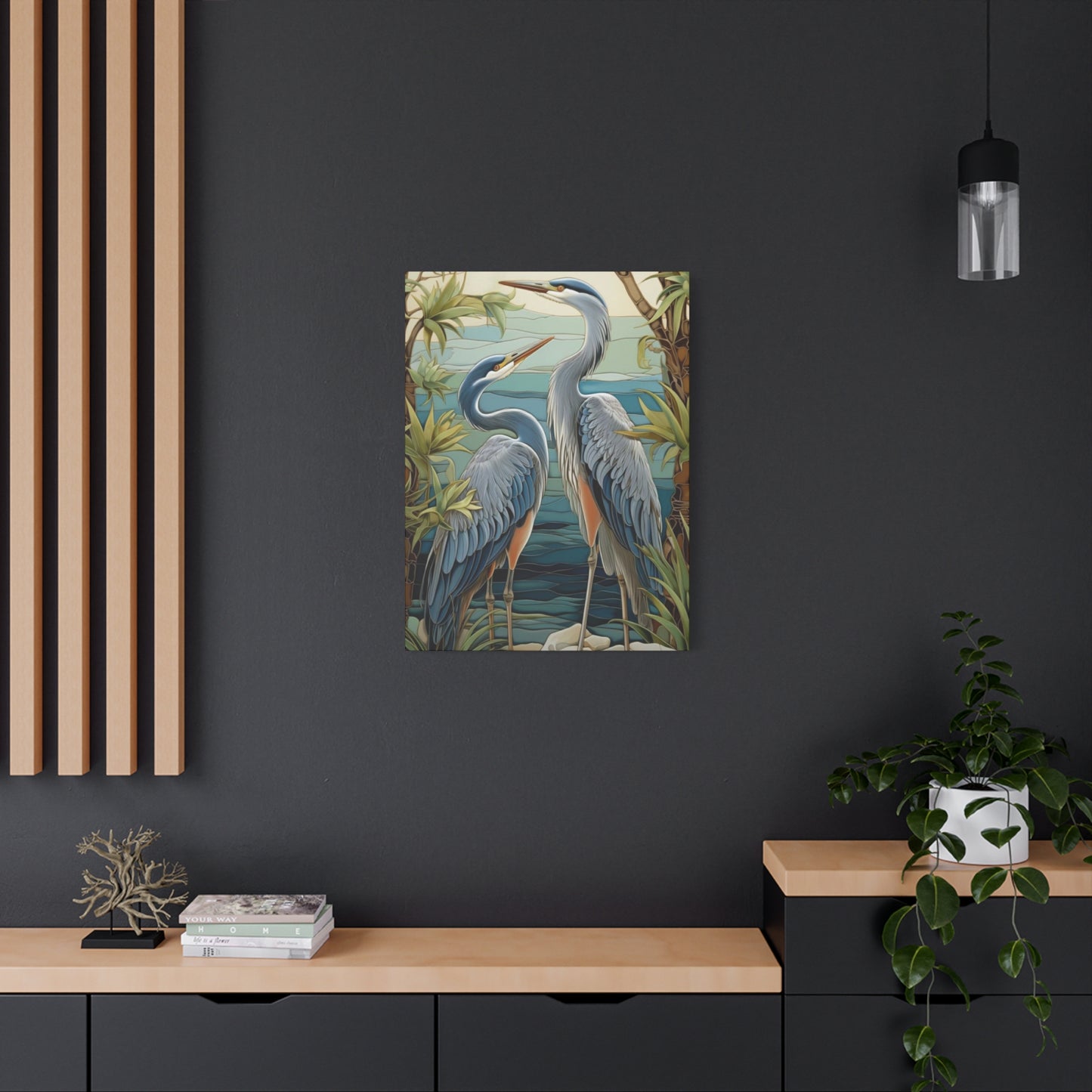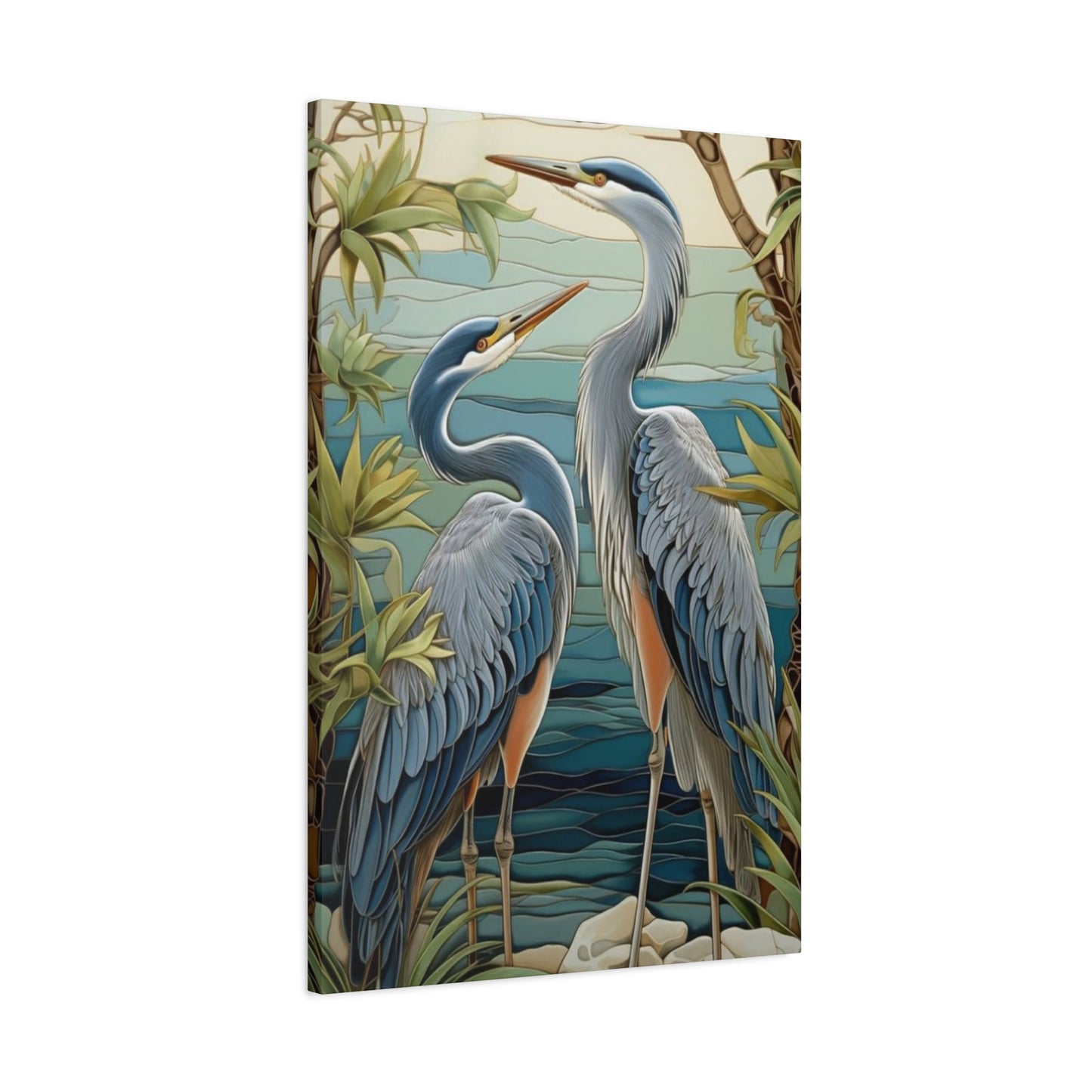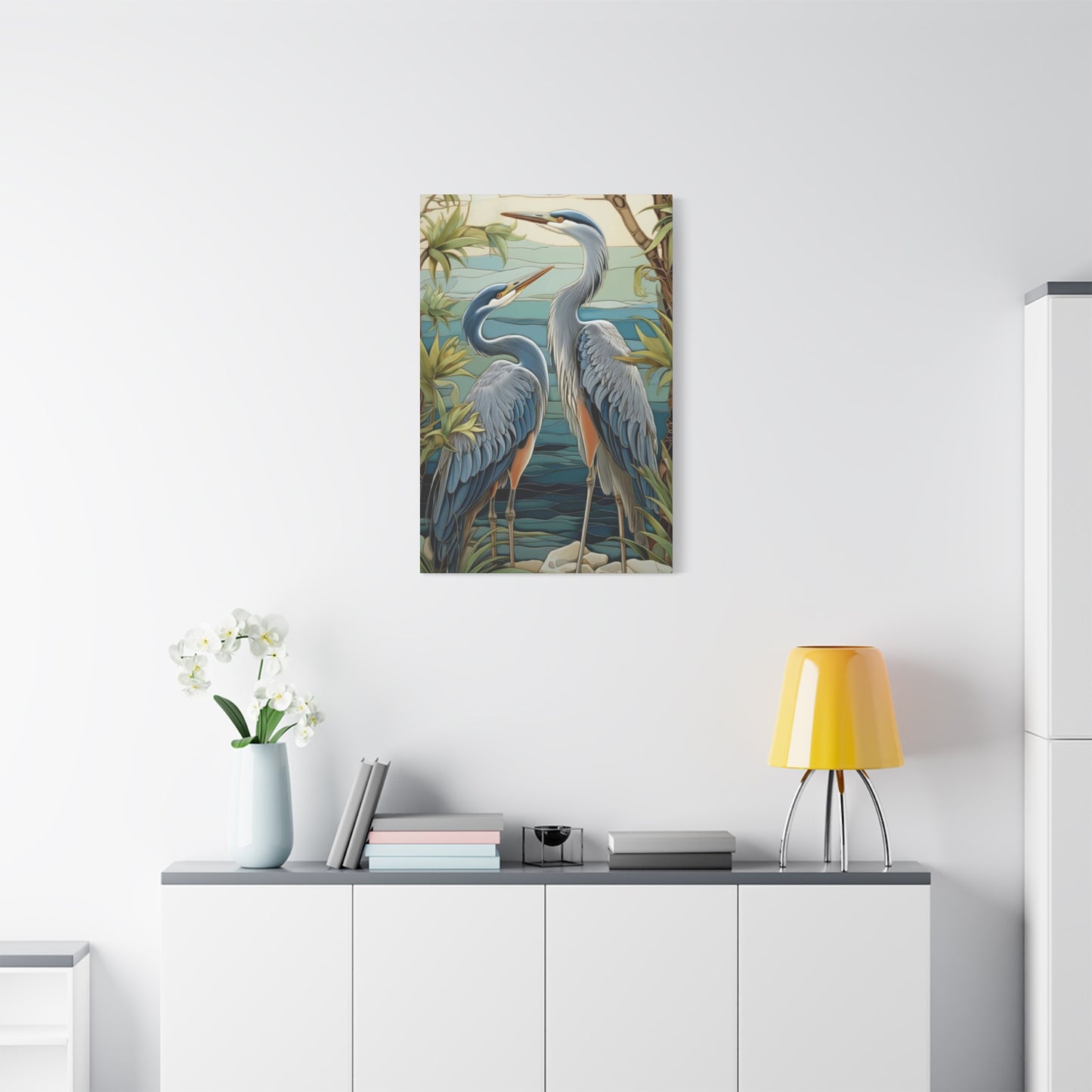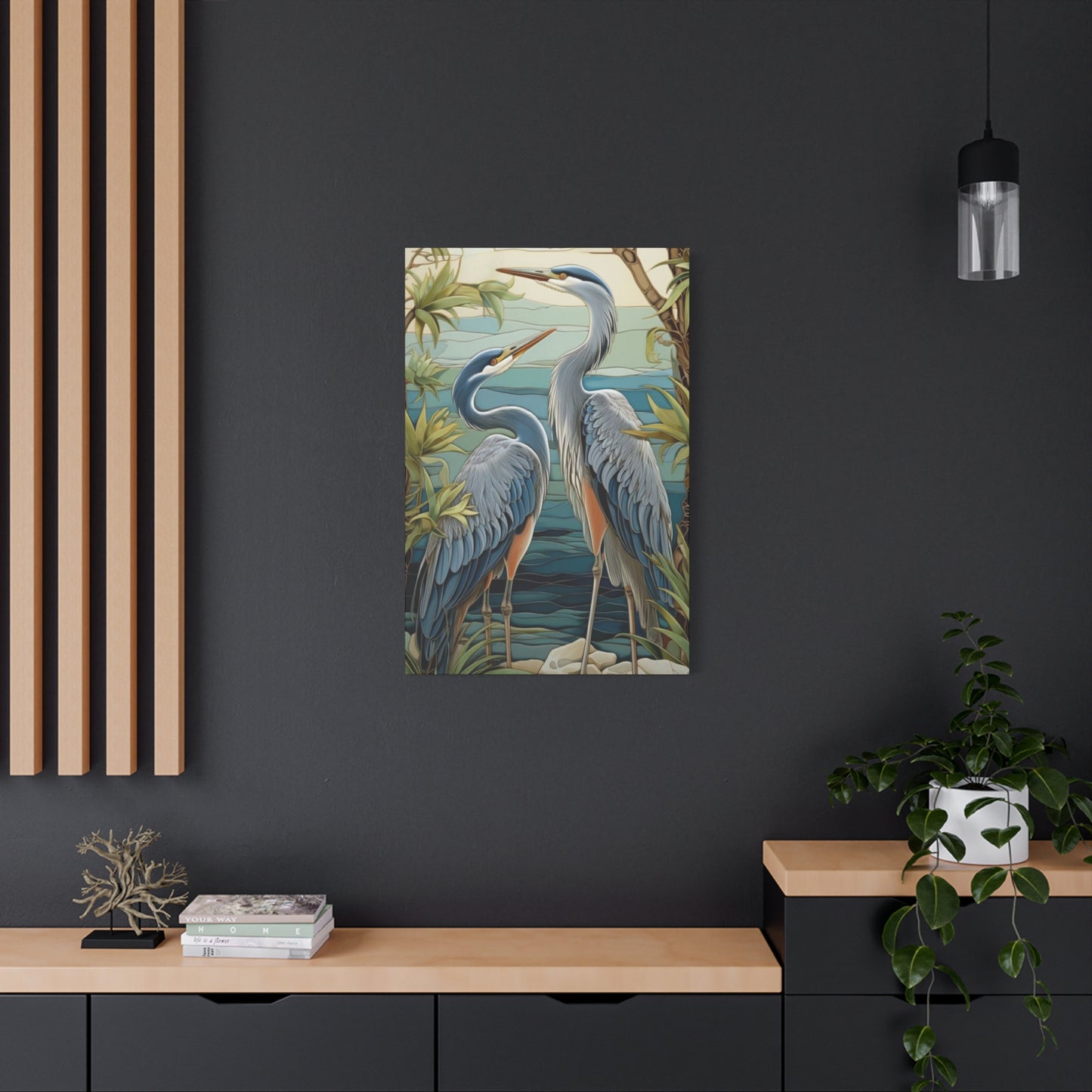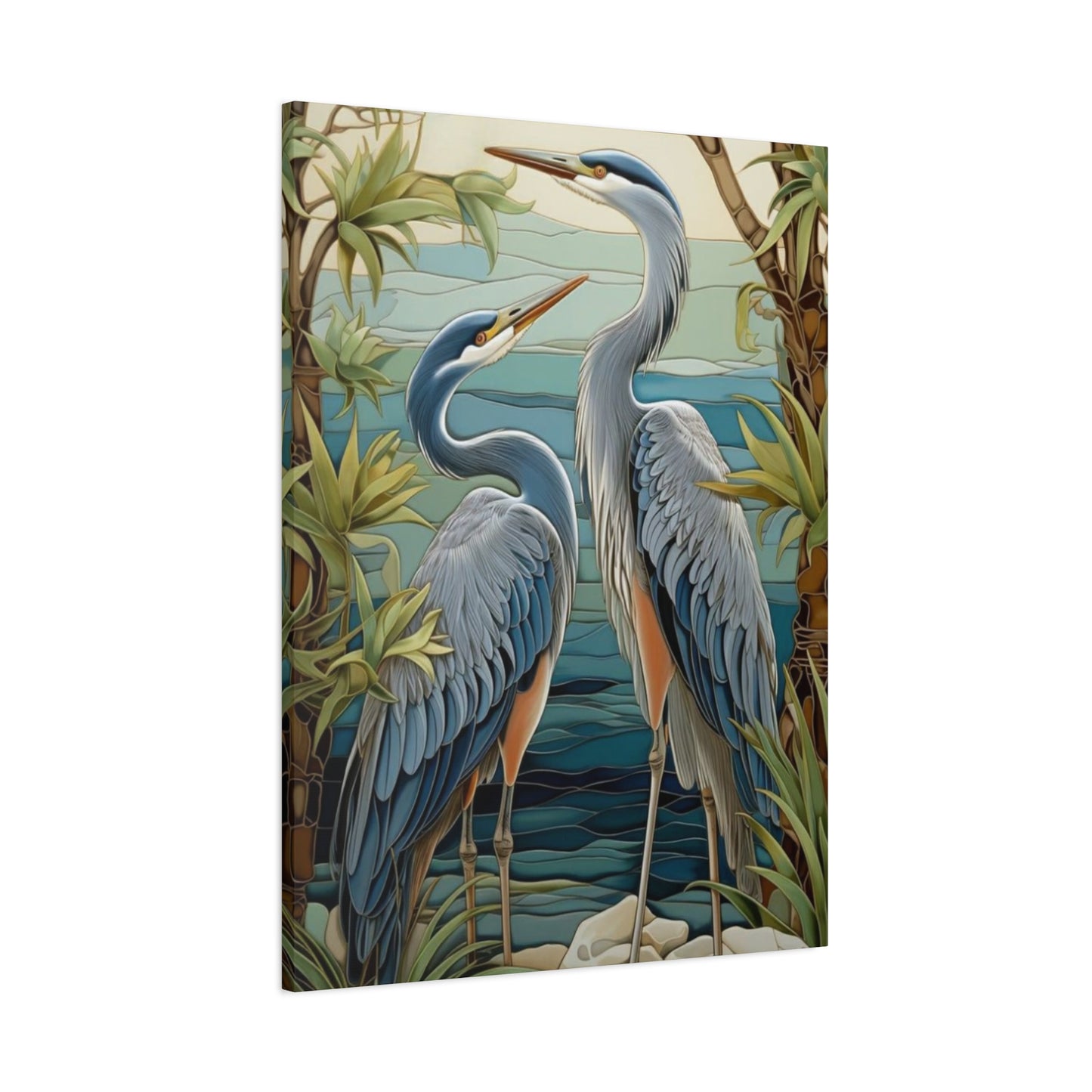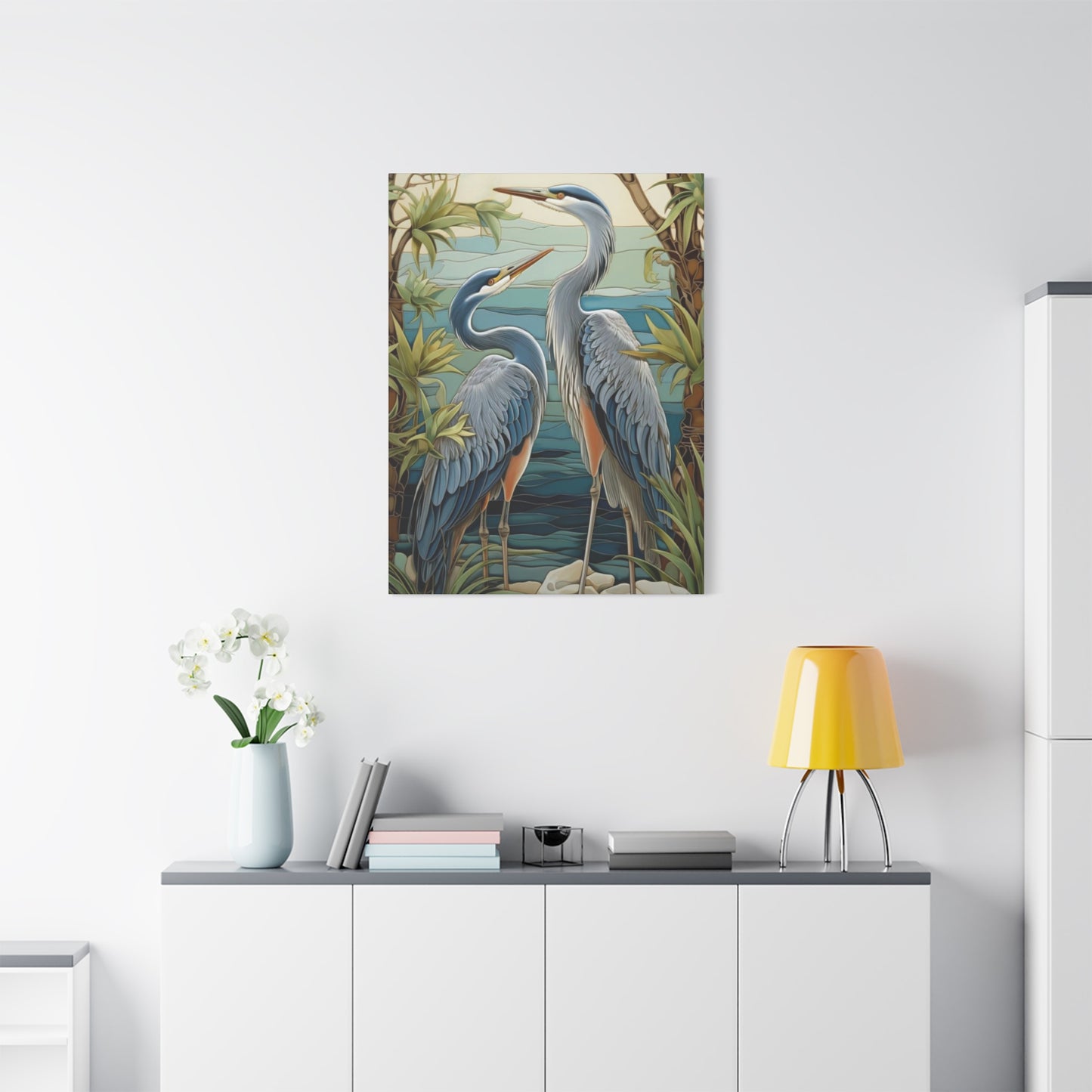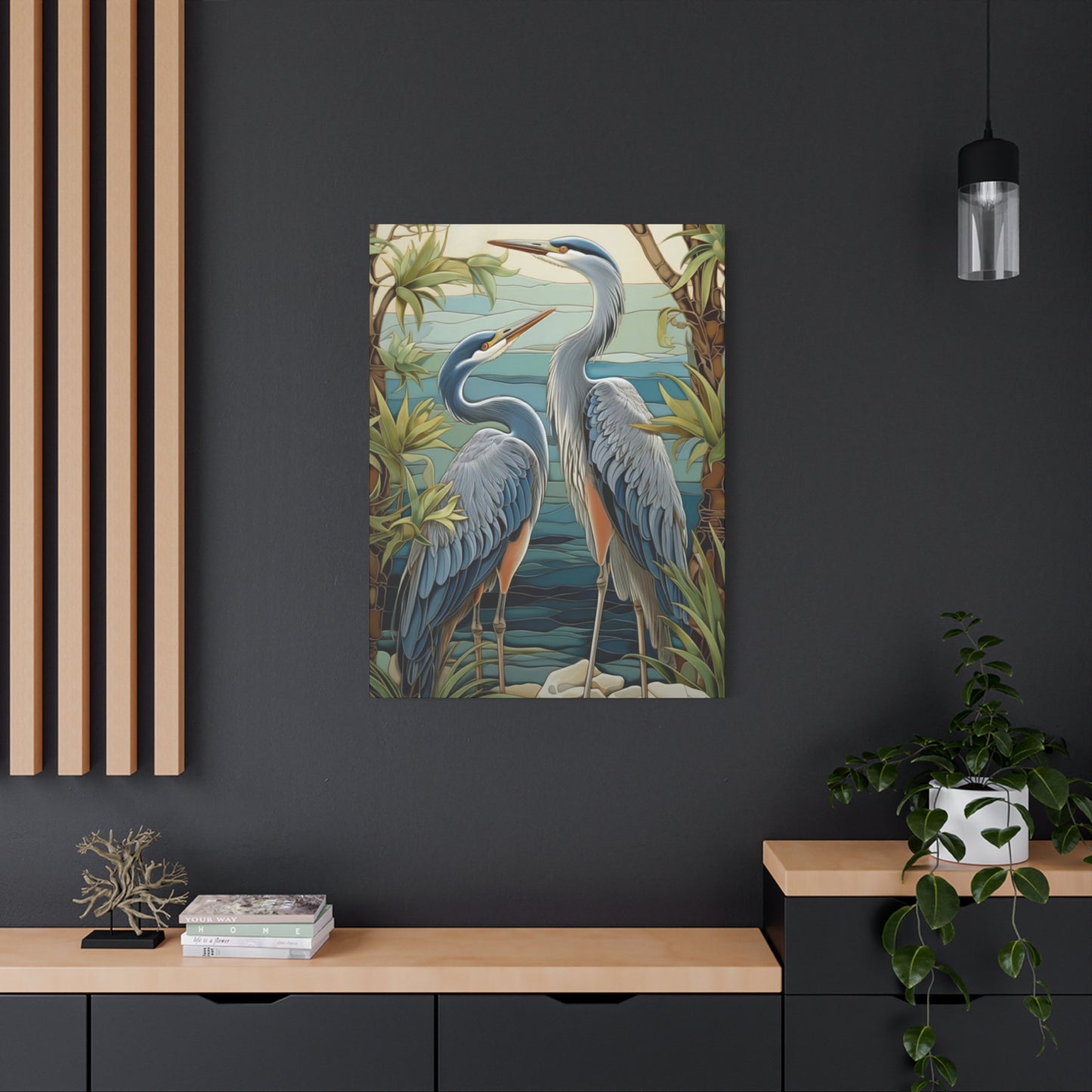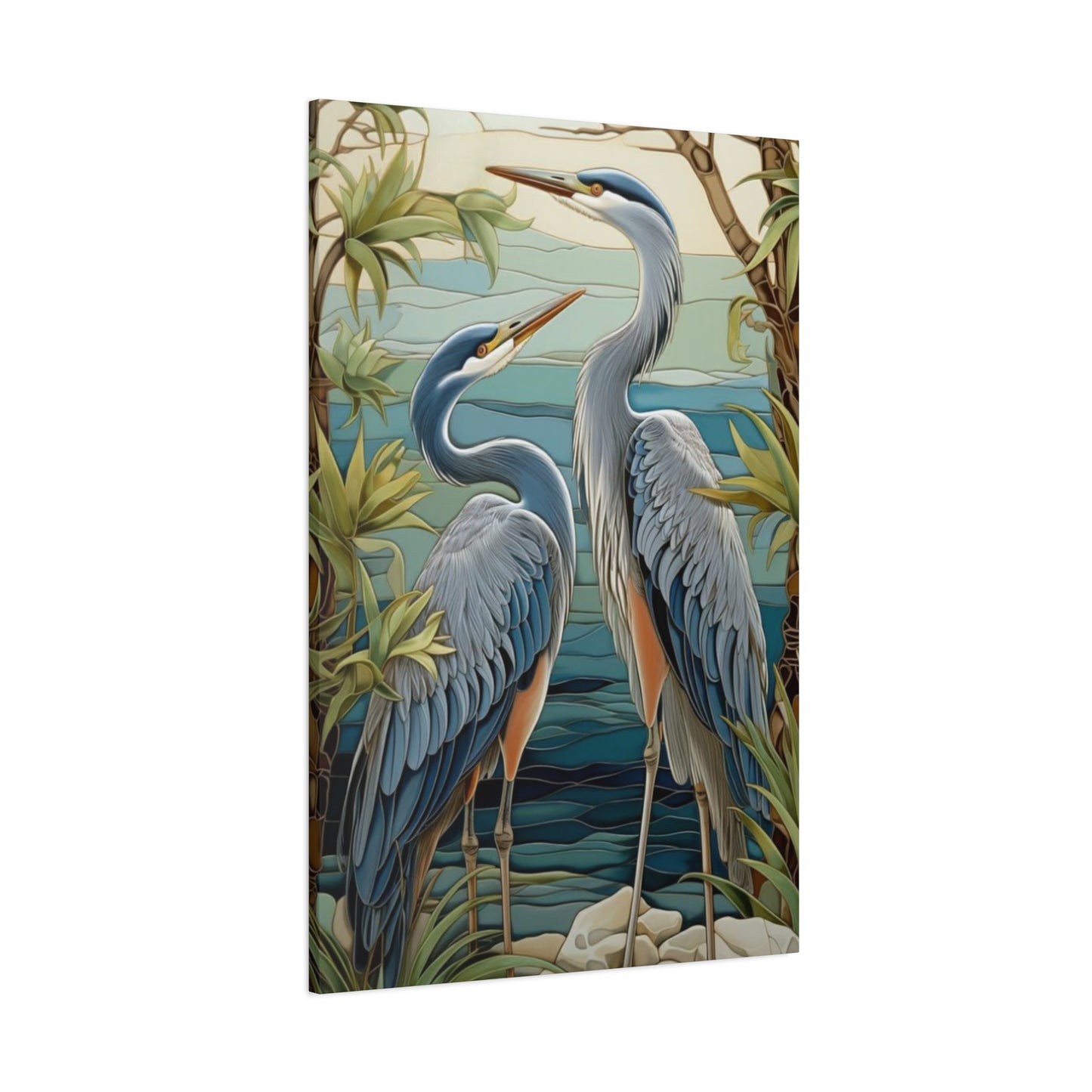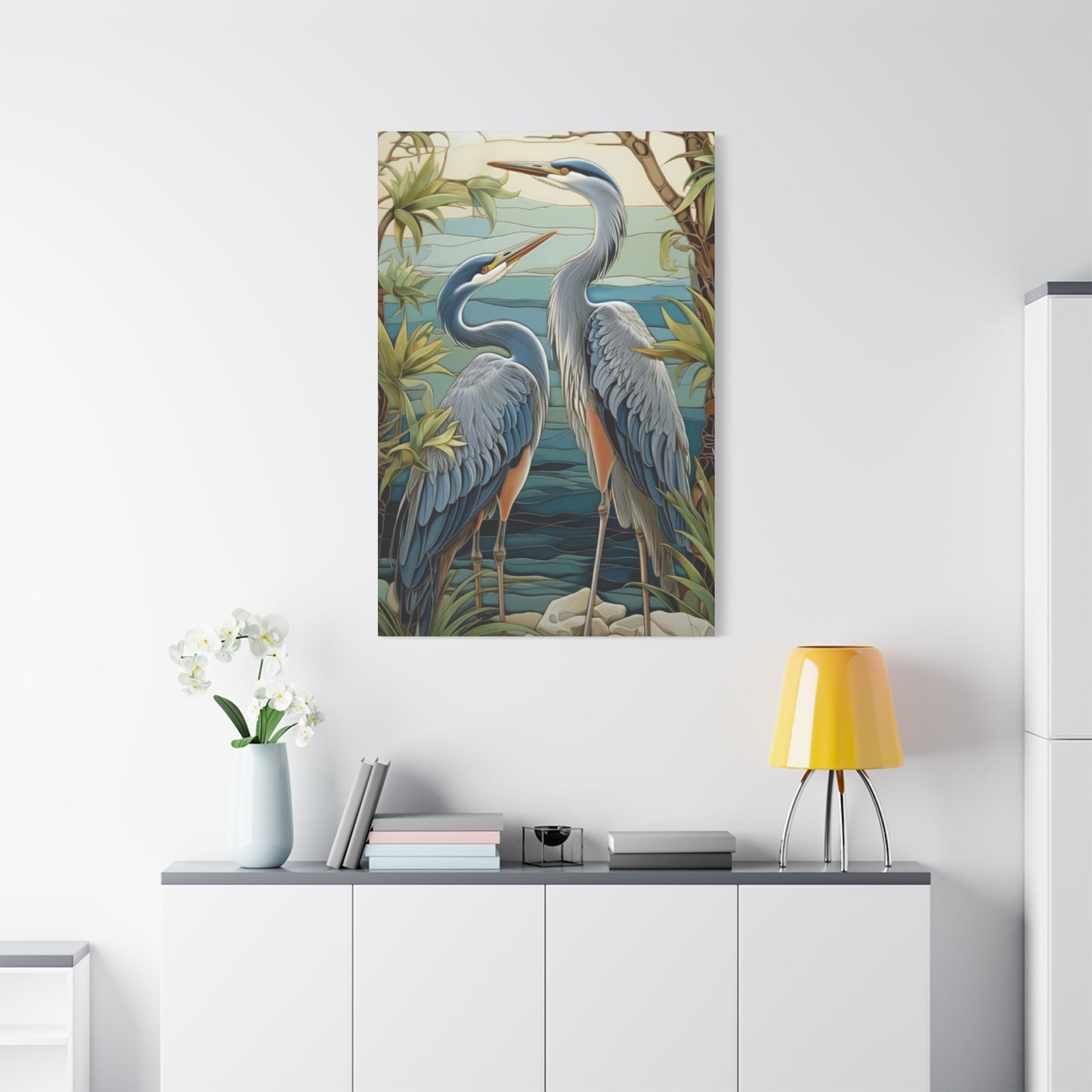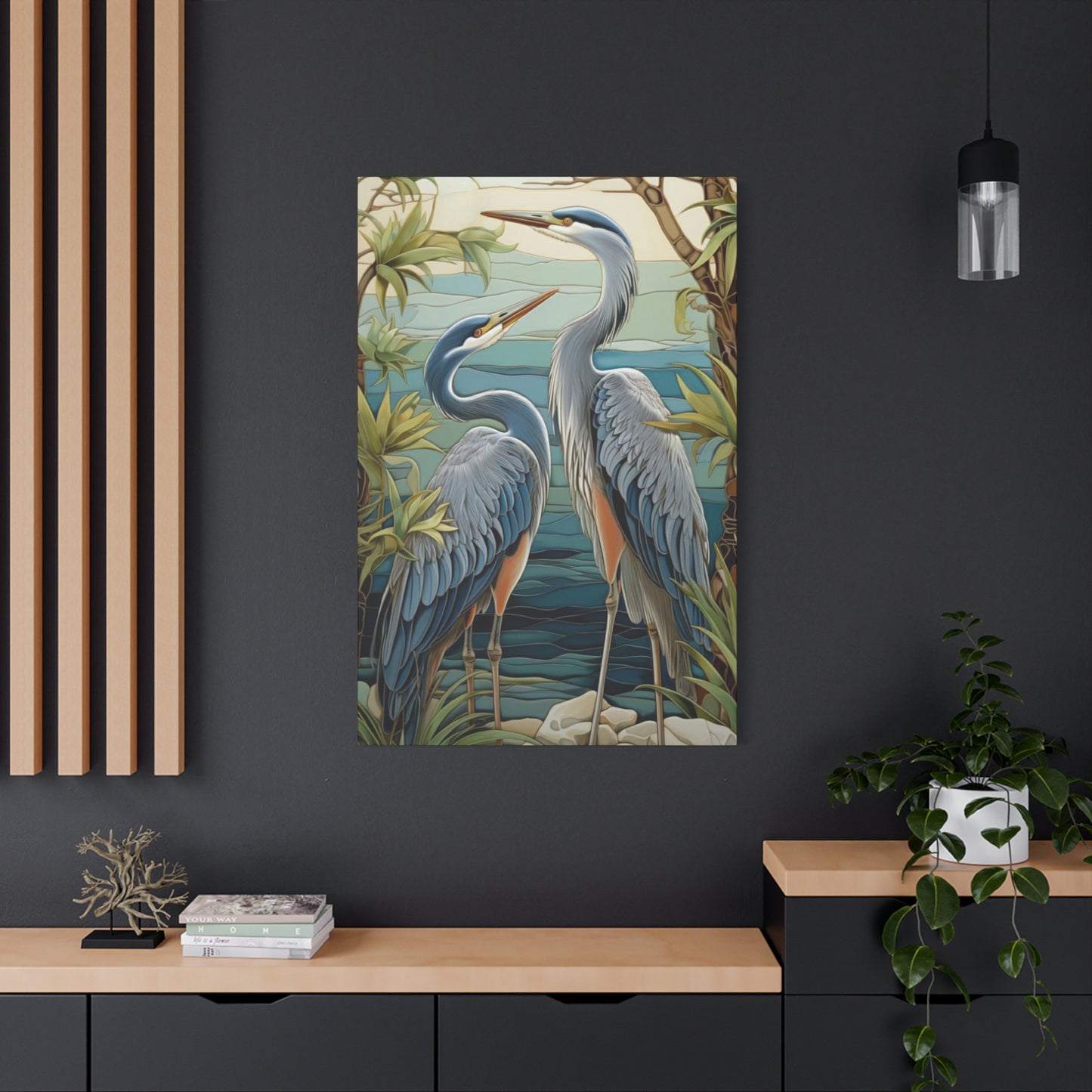Majestic Herons: Premium Wild Bird Wall Art Collections for Nature Enthusiasts
The graceful silhouettes of herons have captivated artists and nature enthusiasts for centuries, making them one of the most sought-after subjects for wildlife wall art. These magnificent birds, with their elegant posture and serene presence, bring an unparalleled sense of tranquility and natural beauty to any environment. When transformed into stunning canvas prints and artistic displays, herons create powerful focal points that connect viewers with the raw beauty of untamed wilderness.
The appeal of heron-themed artwork extends far beyond simple decoration. These pieces serve as windows into pristine wetland ecosystems, marshlands, and coastal regions where these remarkable birds thrive. Each carefully crafted canvas captures the essence of wild herons in their most natural state, whether standing motionless in shallow waters, gracefully taking flight, or patiently hunting among reeds and cattails. The timeless elegance of these creatures makes them perfect subjects for creating atmospheric and sophisticated home environments.
Modern printing technologies have revolutionized how we can bring these majestic birds into our living environments. High-quality canvas reproductions now capture every intricate detail, from the delicate feather patterns to the piercing intensity of their gaze. Whether depicting a solitary great blue heron at dawn or a group of snowy egrets in flight, these artistic interpretations offer viewers an opportunity to experience the wonder of wildlife without leaving their homes.
The versatility of heron-themed artwork makes it suitable for various decorative styles and preferences. From photorealistic representations that showcase the birds in their authentic natural habitats to more artistic interpretations that emphasize mood and atmosphere, there exists a perfect heron canvas for every taste and setting. These pieces work exceptionally well in both contemporary and traditional environments, adding layers of sophistication and natural charm.
Wild Herons Captured on Canvas
Contemporary wildlife photography has elevated heron imagery to new artistic heights, with skilled photographers dedicating countless hours to capturing these elusive birds in their most compelling moments. The resulting canvas prints showcase herons in various poses and settings, each telling a unique story about life in the wild. These photographs often require tremendous patience and expertise, as herons are notoriously cautious creatures that demand respectful observation from considerable distances.
The technical aspects of capturing herons on canvas involve understanding both the birds' behavior patterns and the optimal environmental conditions for photography. Dawn and dusk provide the most dramatic lighting conditions, creating ethereal atmospheres that enhance the natural beauty of these already stunning creatures. During these golden hours, herons become silhouetted against warm skies, creating compositions that are both striking and emotionally evocative.
Professional wildlife photographers often spend months in specific locations, learning the habits and preferred hunting grounds of local heron populations. This dedication results in canvas prints that showcase authentic behavioral moments, from the intense concentration during hunting to the graceful elegance of flight. These genuine captures of wild behavior create artwork that resonates with viewers on a deeper level, offering glimpses into the untamed world that exists beyond human civilization.
The diversity of heron species provides endless artistic possibilities for canvas collections. Great blue herons, with their impressive size and stately bearing, create commanding presence in larger format prints. Meanwhile, smaller species like green herons and night herons offer more intimate compositions that work beautifully in cozy settings. Each species brings its own unique characteristics and visual appeal to canvas artwork.
Modern canvas printing techniques ensure that these wildlife captures retain their original impact and detail. Advanced color reproduction systems faithfully represent the subtle hues found in heron plumage, from the slate blues and grays of great blue herons to the pristine whites of great egrets. The texture and depth achieved through high-quality canvas materials add dimensionality to these prints, creating artwork that appears almost three-dimensional under proper lighting conditions.
Bringing Nature Indoors with Heron Wall Art
The psychological benefits of incorporating nature-themed artwork into living environments have been extensively documented by researchers and wellness experts. Heron wall art serves as a particularly effective medium for creating calming, stress-reducing atmospheres within homes and offices. The serene presence of these birds, even in artistic form, can help reduce anxiety levels and promote feelings of peace and tranquility.
Creating nature-inspired environments through heron artwork involves more than simply hanging pictures on walls. It requires thoughtful consideration of how these pieces interact with existing furnishings, lighting, and architectural elements. The goal is to establish harmonious connections between the artwork and the surrounding environment, creating cohesive compositions that feel natural and unforced.
The placement of heron wall art should take advantage of natural lighting whenever possible. These pieces look particularly stunning when positioned to catch morning or afternoon sunlight, which enhances the natural colors and creates dynamic shadow patterns throughout the day. The changing light conditions can transform the same piece of artwork multiple times daily, providing ongoing visual interest and variety.
Color coordination plays a crucial role in successfully integrating heron artwork into existing decorative schemes. The natural palette of heron images typically includes various shades of blue, gray, brown, and white, making them highly compatible with both warm and cool color schemes. These neutral tones allow heron artwork to complement rather than compete with other decorative elements in the room.
The size and scale of heron wall art should be carefully matched to the intended display location. Large, dramatic pieces work well as statement focal points in spacious areas, while smaller, more intimate compositions are perfect for creating cozy reading nooks or meditation corners. The goal is to create visual balance that enhances rather than overwhelms the existing architectural features of the room.
Grouping multiple heron pieces can create powerful narrative compositions that tell stories about wetland ecosystems and bird behavior. These collections might include various poses, different species, or seasonal variations that showcase the full range of heron beauty and behavior. When thoughtfully arranged, these groupings can transform entire walls into immersive nature experiences.
Choosing Herons-in-the-Wild Canvas Prints
Selecting the perfect heron canvas print requires careful consideration of multiple factors, including artistic style, size requirements, and intended display location. The market offers an impressive variety of options, from photorealistic wildlife portraits to more interpretive artistic renderings that emphasize mood and atmosphere over documentary accuracy. Understanding these different approaches helps buyers make informed decisions that align with their personal preferences and decorative goals.
The artistic style of heron canvas prints varies significantly among different artists and photographers. Some creators focus on capturing herons with documentary precision, showcasing every feather detail and natural coloration with scientific accuracy. These pieces appeal to nature enthusiasts who appreciate authentic wildlife representation and educational value in their artwork. Other artists take more interpretive approaches, using techniques like selective focus, dramatic lighting, or artistic filters to create mood-driven compositions that prioritize emotional impact over literal representation.
Quality considerations should always be paramount when selecting heron canvas prints. Superior printing processes use archival inks that resist fading and maintain color integrity for decades. The canvas material itself should be heavyweight and properly prepared to accept inks without bleeding or color shift. Gallery-wrapped canvases with substantial backing provide durability and create the professional appearance expected from fine art pieces.
The subject matter within heron artwork offers numerous options for personalization. Some buyers prefer solitary bird compositions that emphasize individual character and behavior, while others gravitate toward environmental contexts that showcase herons within their natural wetland habitats. Flight scenes capture dynamic movement and energy, while feeding or hunting scenes provide insight into natural behaviors and survival strategies.
Seasonal variations in heron photography create opportunities for curated collections that reflect natural cycles and environmental changes. Spring imagery might feature herons in breeding plumage or tending to young, while autumn scenes showcase birds preparing for migration or adapting to changing weather conditions. These seasonal themes allow for rotating displays that keep artwork fresh and engaging throughout the year.
The geographical origin of heron photography can also influence selection decisions. Local species and familiar landscapes create personal connections for viewers, while exotic locations and unfamiliar species provide opportunities for armchair travel and cultural exploration. Many collectors enjoy building international heron collections that showcase the global diversity of these magnificent birds.
Serenity in Flight: Heron Wildlife Wall Art
Flight photography represents one of the most challenging and rewarding aspects of heron artwork, capturing these magnificent birds in their most dynamic and graceful moments. The technical difficulty of photographing herons in flight requires specialized equipment, extensive experience, and considerable patience, making successful flight images particularly valuable and impressive additions to any wildlife art collection.
The biomechanics of heron flight create naturally elegant compositions that translate beautifully to canvas artwork. Their slow, deliberate wingbeats and extended neck posture create flowing lines that guide the viewer's eye across the composition. The contrast between the bird's detailed plumage and simplified background elements creates striking visual impact that works effectively in various decorative settings.
Different flight phases offer distinct artistic opportunities for heron wall art. Takeoff sequences capture explosive energy as birds launch from water surfaces, creating dramatic splashing effects and dynamic wing positions. Sustained flight imagery showcases the graceful efficiency of heron locomotion, with wings fully extended and bodies streamlined for optimal performance. Landing sequences provide opportunities for capturing the delicate precision required for successful water entries.
Environmental contexts significantly influence the emotional impact of flight-themed heron artwork. Birds photographed against storm clouds create dramatic, moody compositions that suggest power and resilience. Dawn or sunset lighting transforms flying herons into silhouetted forms against colorful skies, emphasizing shape and movement over detail. Open water backgrounds provide clean, uncluttered compositions that focus attention entirely on the bird's form and motion.
The psychological impact of flight imagery extends beyond simple aesthetic appreciation. These pieces can evoke feelings of freedom, grace, and transcendence that resonate deeply with viewers seeking to escape the constraints of modern life. The apparent effortlessness of heron flight serves as a powerful metaphor for overcoming obstacles and rising above challenges.
Technical considerations for displaying flight-themed heron artwork include optimal viewing angles and lighting conditions. These dynamic compositions often benefit from strategic positioning that allows viewers to appreciate the sense of movement and direction inherent in the imagery. Proper lighting can enhance the three-dimensional qualities of extended wings and create shadows that add depth and realism to the overall composition.
Herons in Natural Habitats: Canvas Decor Ideas
Environmental context plays a crucial role in creating compelling heron artwork that tells complete stories about these remarkable birds and their ecosystems. Natural habitat imagery provides viewers with educational insights while creating visually rich compositions that showcase the intricate relationships between wildlife and their environments. These pieces serve dual purposes as both decorative art and windows into complex ecological systems.
Wetland environments offer the most diverse and visually interesting backdrops for heron photography. Marshlands with cattails, reeds, and water lilies create layered compositions that provide depth and context for bird subjects. The interplay between vegetation patterns, water reflections, and bird positioning creates complex visual relationships that reward careful viewing and contemplation.
Seasonal changes in habitat environments provide opportunities for varied artistic expressions throughout the year. Spring wetlands burst with new growth and vibrant greens that complement the blues and grays of heron plumage. Summer scenes feature lush vegetation and abundant food sources that showcase the productivity of healthy ecosystems. Autumn imagery captures the golden and bronze tones of dying vegetation, creating warm, nostalgic compositions that celebrate the beauty of natural cycles.
Water elements within heron habitat artwork serve multiple compositional functions beyond simple environmental accuracy. Reflections create symmetrical patterns that double the visual impact of bird subjects, while ripple patterns add movement and energy to otherwise static compositions. The interaction between birds and water surfaces, whether through feeding activities or simple drinking behaviors, provides narrative elements that engage viewers and tell stories about survival and adaptation.
The integration of multiple species within habitat-focused heron artwork creates opportunities for educational and visually complex compositions. These pieces might include various heron species alongside other wetland birds, creating diverse communities that reflect the reality of shared ecosystem resources. Understanding the ecological relationships between different species adds depth and authenticity to habitat-themed artwork.
Lighting conditions within natural habitats significantly influence the mood and character of resulting artwork. Early morning mist creates ethereal, dreamlike qualities that suggest mystery and tranquility. Harsh midday lighting emphasizes texture and detail in both birds and vegetation. Late afternoon golden hour lighting transforms ordinary wetland scenes into magical, otherworldly landscapes that captivate viewers and create lasting impressions.
Coastal Living with Herons-in-Wild Prints
Coastal regions provide some of the most spectacular settings for heron photography, combining the natural beauty of these magnificent birds with the dramatic landscapes of shorelines, estuaries, and tidal zones. The unique characteristics of coastal environments create artistic opportunities that differ significantly from inland wetland photography, offering collectors specialized pieces that celebrate both avian beauty and maritime atmospheres.
The variety of coastal habitats frequented by herons provides diverse artistic possibilities for wall art collections. Rocky shorelines create dramatic contrasts between organic bird forms and geometric stone formations. Sandy beaches offer clean, minimalist compositions that emphasize bird subjects against simplified backgrounds. Salt marshes and tidal pools provide complex, textured environments that showcase the intricate relationships between birds and their feeding grounds.
Tidal influences in coastal environments create dynamic conditions that change throughout the day, providing photographers with constantly evolving opportunities for unique compositions. Low tide exposes feeding areas and creates interesting patterns in wet sand and exposed mud flats. High tide concentrates birds in smaller areas and creates different hunting strategies that result in varied behavioral photography opportunities.
The atmospheric conditions common in coastal regions contribute significantly to the emotional impact of heron artwork. Morning fog creates mysterious, ethereal qualities that suggest solitude and contemplation. Storm systems approaching from the ocean provide dramatic sky backgrounds that emphasize the resilience and adaptability of coastal wildlife. Clear, bright conditions showcase the vibrant colors and crisp details that make these birds such compelling photographic subjects.
Coastal heron species often display different characteristics and behaviors compared to their inland relatives, providing collectors with opportunities to explore specialized variations within their artwork collections. Great blue herons in coastal environments may exhibit different hunting strategies adapted to tidal conditions. Specialized coastal species like tricolored herons or reddish egrets offer unique photographic opportunities that cannot be found in inland locations.
The integration of coastal elements like driftwood, seaweed, and wave action into heron photography creates layered compositions that tell complete stories about life along shorelines. These environmental details provide context and educational value while adding visual interest and complexity to the overall composition. The natural patterns and textures found in coastal environments complement the organic forms of heron subjects, creating harmonious and visually satisfying artwork.
Framing Tips for Heron Wildlife Canvas Art
Proper framing serves as the crucial final step in presenting heron canvas artwork effectively, protecting valuable pieces while enhancing their visual impact and integration with surrounding decor. The framing choices made for wildlife art can significantly influence how viewers perceive and interact with the artwork, making thoughtful selection essential for maximizing both aesthetic appeal and long-term preservation.
Frame materials should complement rather than compete with the natural subjects depicted in heron artwork. Wood frames in natural finishes like oak, walnut, or cherry create organic connections between the artwork and its presentation, reinforcing the nature theme while providing warm, welcoming appearances. Metal frames in bronze or pewter finishes offer more contemporary alternatives that can work well with modern decorative schemes while maintaining appropriate restraint.
The width and profile of frame moldings should be proportionate to both the size of the artwork and the scale of the surrounding environment. Larger heron canvases often benefit from substantial frames that provide adequate visual weight and presence, while smaller pieces may be overwhelmed by heavy moldings. The goal is to create balanced presentations that enhance rather than dominate the artwork itself.
Color considerations in frame selection should account for both the dominant hues within the heron artwork and the broader color scheme of the display environment. Neutral frame colors like warm grays, soft browns, or cream tones typically provide safe choices that won't clash with the natural color palette of heron photography. More adventurous collectors might consider frames that pick up accent colors from within the artwork, creating coordinated presentations that feel intentional and sophisticated.
Matting options for heron canvas prints require careful consideration of both aesthetic and preservation factors. When used, mats should be cut from acid-free materials to prevent long-term damage to the artwork. The width of mat borders should be proportionate to the overall composition, with wider mats generally appropriate for smaller artworks and narrower mats suitable for larger pieces. Color selection should remain neutral to avoid competing with the artwork itself.
The decision between glass and acrylic glazing involves balancing protection, appearance, and practical considerations. Museum-quality glazing materials offer superior protection from ultraviolet radiation and environmental contaminants while providing excellent optical clarity. Anti-reflective treatments can be particularly beneficial for heron artwork displayed in bright environments or areas with multiple light sources that might create problematic reflections.
Herons in Marshes and Wetlands: Art for the Home
Marsh and wetland environments represent the quintessential habitats for most heron species, making artwork featuring these settings particularly authentic and educationally valuable. The complex ecosystems found in wetland environments provide rich, layered backgrounds that create visually compelling compositions while showcasing the intricate relationships between wildlife and their natural surroundings.
The botanical diversity found in wetland environments offers numerous opportunities for creating varied and interesting artistic compositions. Cattails provide vertical elements that complement the upright posture of feeding herons, while water lilies and lotus plants add horizontal patterns and color variations. The interplay between different plant species creates natural frames and compositional elements that enhance the overall visual impact of heron subjects.
Seasonal changes in marsh environments create dramatically different artistic opportunities throughout the year. Spring wetlands feature fresh green growth and abundant wildlife activity, creating energetic, life-affirming compositions. Summer scenes showcase the lush productivity of established ecosystems, with dense vegetation and diverse animal communities. Autumn marshes display spectacular color changes as vegetation prepares for winter dormancy, creating warm, nostalgic atmospheres perfect for home decor.
The water elements within marsh environments serve multiple compositional and ecological functions that translate effectively into artwork. Still water surfaces create mirror-like reflections that double the visual impact of heron subjects, while gentle ripples add subtle movement and energy. The interaction between herons and water through feeding, drinking, or bathing behaviors provides narrative elements that engage viewers and tell stories about natural survival strategies.
Wildlife diversity in marsh environments creates opportunities for complex, multi-species compositions that showcase entire ecosystem communities. Heron artwork might include other wetland birds like ducks, geese, or rails, creating dynamic scenes that reflect the reality of shared habitat resources. Understanding these ecological relationships adds educational value and authenticity to marsh-themed artwork.
Lighting conditions in marsh environments can dramatically influence the mood and character of resulting artwork. Early morning light filtering through marsh vegetation creates soft, diffused illumination that enhances the peaceful qualities of these environments. Late afternoon lighting can transform ordinary marsh scenes into golden, magical landscapes that capture the imagination and create lasting emotional connections with viewers.
Birdwatcher's Favorite: Wild Heron Wall Decor
Serious birdwatchers and ornithology enthusiasts represent a specialized market for heron wall decor, seeking artwork that combines aesthetic appeal with scientific accuracy and educational value. These knowledgeable collectors appreciate authentic behavioral documentation, accurate species representation, and environmental contexts that reflect genuine wildlife encounters rather than artistic interpretations that prioritize style over substance.
The scientific accuracy required for birdwatcher-oriented artwork demands extensive knowledge of heron anatomy, behavior, and habitat preferences. Artists and photographers working in this market must understand subtle differences between similar species, seasonal plumage variations, and typical behavioral patterns that distinguish authentic wildlife documentation from generic bird imagery. This attention to detail creates artwork that satisfies the discerning eye of experienced birders while maintaining broad appeal for general nature enthusiasts.
Behavioral documentation within heron artwork provides valuable educational opportunities that extend beyond simple aesthetic appreciation. Images capturing specific hunting techniques, courtship displays, or parental care behaviors offer insights into the complex lives of these remarkable birds. Such documentation serves dual purposes as both decorative art and educational resources that can enhance understanding and appreciation of wildlife conservation issues.
Species identification features must be clearly visible and accurately represented in artwork intended for birdwatching audiences. The subtle differences between great blue herons and great egrets, or the distinctive characteristics that separate green herons from other small heron species, must be faithfully reproduced to satisfy knowledgeable viewers. This accuracy requirement often influences composition choices and photographic techniques used in creating birdwatcher-oriented artwork.
Geographic and habitat accuracy also plays important roles in creating authentic birdwatcher-approved artwork. Different heron species have specific range limitations and habitat preferences that must be respected in realistic photography. A great blue heron photographed in appropriate North American wetland habitat carries more authenticity and educational value than artistic interpretations that ignore these biological realities.
The seasonal timing of heron photography can provide valuable phenological information that appeals to serious birders. Images that capture birds in breeding plumage, during migration periods, or exhibiting season-specific behaviors offer documentary value that transcends simple decoration. This temporal accuracy creates artwork that tells complete stories about annual cycles and ecological adaptation strategies.
Canvas Prints of Herons in Their Natural Element
High-quality canvas reproduction technology has revolutionized the presentation of wildlife photography, allowing artists to create museum-quality prints that faithfully reproduce the subtle details and color nuances found in original heron photographs. Modern printing processes can capture everything from individual feather patterns to the delicate color gradations found in natural lighting conditions, creating artwork that rivals traditional photographic prints in quality and longevity.
The technical specifications required for producing superior heron canvas prints involve multiple factors including ink quality, canvas preparation, and color calibration systems. Archival pigment inks resist fading and color shift for decades when properly displayed, ensuring that investment-quality artwork maintains its original appearance throughout its useful life. Canvas materials must be properly primed and tensioned to accept inks without bleeding while providing stable, long-lasting support for the printed image.
Color accuracy becomes particularly critical when reproducing the subtle hues found in heron plumage and natural environments. Professional color management systems ensure that printed reproductions match the original photography as closely as possible, preserving the authentic appearance of natural subjects. This accuracy is especially important for educational or scientific applications where realistic color representation enhances the documentary value of the artwork.
The texture and surface characteristics of canvas materials contribute significantly to the final appearance and impact of heron prints. Fine-weave canvases provide smooth surfaces that excel at reproducing fine details and subtle color gradations, while coarser textures add dimensional qualities that can enhance the organic feel of wildlife subjects. The choice between different canvas textures should consider both the characteristics of the original photography and the intended display environment.
Gallery wrapping techniques for canvas prints eliminate the need for traditional framing while creating clean, contemporary presentations that work well in modern decorative schemes. The continuation of the image around the canvas edges creates three-dimensional effects that add depth and presence to wall installations. This presentation method particularly suits heron artwork, as it eliminates barriers between viewers and the natural subjects depicted.
Size considerations for canvas prints must balance impact, detail resolution, and practical display requirements. Larger prints create dramatic focal points that can anchor entire room designs, while smaller formats work well for intimate settings or grouped installations. The resolution capabilities of the original photography often determine the maximum effective print size for maintaining crisp detail and professional appearance.
Using Wild Heron Art in Rustic Decorating Themes
Rustic decorative schemes create natural partnerships with wild heron artwork, as both celebrate the beauty and authenticity of natural environments. The organic textures, earth-tone color palettes, and nature-focused themes common in rustic design provide perfect backdrops for showcasing the elegant beauty of heron subjects while reinforcing the overall aesthetic philosophy of bringing the outdoors inside.
Material coordination between rustic furnishings and heron artwork creates cohesive design schemes that feel organic and unforced. Reclaimed wood furniture, stone accents, and natural fiber textiles complement the natural subjects depicted in heron photography, creating harmonious relationships between different design elements. The key lies in maintaining balance between rustic elements and artistic sophistication, avoiding overly casual presentations that diminish the impact of quality wildlife art.
Color palette integration requires careful attention to the natural hues found in both heron artwork and rustic decorative schemes. The blues, grays, and earth tones common in heron photography work beautifully with the warm browns, deep greens, and cream colors typical of rustic design. These natural color relationships create soothing, harmonious environments that promote relaxation and connection with nature.
Textural contrasts between smooth canvas prints and rough rustic materials can create visually interesting compositions that add depth and complexity to room designs. The sleek surface of modern canvas prints provides elegant counterpoints to weathered wood surfaces, natural stone elements, or woven textile accessories. This interplay between refined and rustic elements creates sophisticated country aesthetics that appeal to contemporary sensibilities.
Grouping strategies for heron artwork in rustic settings should emphasize natural, asymmetrical arrangements that mirror the organic patterns found in nature. Rather than formal, geometric groupings, rustic presentations benefit from more casual, flowing arrangements that suggest the random beauty of natural environments. Different sizes and orientations can create dynamic compositions that feel spontaneous and authentic.
Lighting considerations for rustic environments often involve warmer color temperatures that enhance the cozy, intimate qualities associated with country decorating themes. Warm lighting can enhance the earth tones present in many heron photographs while creating inviting atmospheres perfect for relaxation and contemplation. The goal is to create environments where the artwork feels naturally integrated rather than formally displayed.
Peaceful Landscapes with Heron Wall Prints
The inherent tranquility associated with heron imagery makes these subjects particularly effective for creating peaceful, stress-reducing environments within homes and offices. The meditative quality of wetland landscapes combined with the serene presence of these majestic birds produces artwork that actively contributes to wellness and mental health through visual therapy and nature connection.
Psychological research has documented the positive effects of nature imagery on stress reduction, mood improvement, and cognitive function. Heron wall prints leverage these benefits by providing constant access to peaceful natural scenes that can serve as mental refuges from the demands of modern life. The slow, deliberate movements typical of heron behavior translate into static imagery that promotes calm contemplation and mindful observation.
Composition elements within peaceful heron landscapes contribute significantly to their therapeutic qualities. Horizontal water surfaces create stable, grounding elements that suggest permanence and reliability. Soft, diffused lighting conditions minimize harsh contrasts and create gentle, soothing visual experiences. The vertical forms of herons themselves provide focal points for meditation and contemplative viewing without creating visual tension or anxiety.
Color psychology plays an important role in maximizing the peaceful qualities of heron artwork. The cool blues and grays commonly found in wetland photography have been shown to reduce blood pressure and promote feelings of calm and tranquility. Green vegetation elements contribute to stress reduction and mental restoration, while neutral earth tones provide grounding influences that create stable, secure emotional responses.
Scale relationships within peaceful heron landscapes should emphasize the birds' integration with their environments rather than dramatic isolation or dominance. Compositions that show herons as natural parts of larger ecosystems create holistic impressions that promote feelings of connection and belonging. This ecological perspective can help viewers develop broader environmental awareness and appreciation for natural systems.
The strategic placement of peaceful heron artwork within living environments can maximize its therapeutic benefits. Locations where people spend significant time in contemplative activities, such as reading areas, meditation corners, or bedrooms, provide optimal opportunities for meaningful interaction with calming nature imagery. The goal is to create quiet sanctuaries where the artwork contributes to overall wellness and quality of life.
Realistic Wildlife Art: Herons in Motion
Motion capture in heron photography represents one of the most technically challenging and artistically rewarding aspects of wildlife art, requiring split-second timing, advanced equipment, and intimate knowledge of bird behavior patterns. The resulting imagery showcases these magnificent creatures in their most dynamic moments, creating artwork that celebrates the grace, power, and athletic ability of wild herons.
The biomechanics of heron movement provide fascinating subjects for artistic interpretation, from the explosive power of takeoff sequences to the delicate precision required for successful hunting strikes. Each type of movement offers unique compositional opportunities that can create dramatically different emotional impacts and visual experiences. Understanding these behavioral patterns allows artists to anticipate and capture decisive moments that define the essential character of these remarkable birds.
Feeding behavior photography captures some of the most intense and focused moments in heron life, showcasing the lightning-fast strikes and incredible accuracy required for aquatic hunting success. These images often feature extended neck positions, piercing gazes, and dynamic water interactions that create compelling action sequences. The concentration and intensity visible in hunting herons translate into powerful artwork that commands attention and respect from viewers.
Flight photography presents entirely different technical and artistic challenges, requiring equipment capable of tracking rapid movement while maintaining sharp focus and proper exposure. The resulting imagery captures the flowing grace of extended wings, the streamlined efficiency of flight posture, and the apparent effortlessness of aerial locomotion. These dynamic compositions work particularly well as large-format prints that allow viewers to appreciate the full scope of heron elegance and athletic ability.
Courtship and social behavior documentation provides insights into the complex emotional lives of herons, showcasing interactions that reveal personality and individual character. These behavioral moments often involve dramatic posturing, intricate displays, and intimate interactions that create emotionally resonant artwork. Such imagery helps viewers develop deeper connections with wildlife by revealing the sophisticated social structures that govern heron communities.
Environmental interaction photography captures herons as they navigate and manipulate their surroundings, whether through nest building, territorial displays, or habitat modification behaviors. These images showcase the intelligence and adaptability of these remarkable birds while providing educational insights into their ecological roles and environmental impacts. The resulting artwork serves both aesthetic and educational purposes, promoting greater understanding and appreciation for wildlife conservation.
Top Heron Canvas Prints for Nature Lovers
Nature enthusiasts seeking the finest heron canvas prints should prioritize several key factors including artistic excellence, technical quality, species authenticity, and environmental accuracy. The market offers numerous options ranging from documentary wildlife photography to interpretive artistic renderings, each serving different aesthetic preferences and decorative purposes. Understanding these distinctions helps collectors make informed decisions that align with their personal tastes and display requirements.
Photographic realism represents one of the most popular approaches to heron canvas art, appealing to viewers who appreciate authentic wildlife documentation and educational value. These pieces typically feature sharp focus, accurate colors, and detailed environmental contexts that showcase herons in their natural habitats. The best examples combine technical excellence with compelling compositions that capture the essence of wild bird behavior and ecosystem relationships.
Artistic interpretation offers alternative approaches that prioritize mood, atmosphere, and emotional impact over strict documentary accuracy. These pieces might employ selective focus, enhanced colors, or creative compositions that emphasize the aesthetic qualities of heron subjects while maintaining recognizable natural characteristics. Such approaches appeal to collectors seeking artwork that functions primarily as decoration while retaining connections to wildlife themes.
Species diversity within heron collections provides opportunities for educational exploration and visual variety. Great blue herons offer commanding presence and impressive scale, while smaller species like green herons or black-crowned night herons provide more intimate compositions. International species like gray herons or purple herons introduce exotic elements that can expand cultural and geographical perspectives within wildlife art collections.
Seasonal variations in heron photography create opportunities for curated collections that reflect natural cycles and environmental changes. Spring breeding plumage often features enhanced colors and elaborate ornamentation that create particularly striking artwork. Autumn and winter imagery might emphasize survival adaptations and environmental challenges, providing different emotional contexts and educational opportunities.
Quality assessment for heron canvas prints should evaluate both the original photography and the reproduction processes used to create the final artwork. Superior original images feature sharp focus, appropriate exposure, and compelling compositions that translate effectively to canvas format. High-quality printing processes use archival materials and color-accurate reproduction systems that ensure long-lasting beauty and investment protection.
Geographic authenticity adds significant value to heron artwork by providing educational context and regional relevance. Images captured in recognizable local environments create personal connections for viewers while supporting broader environmental awareness initiatives. International photography can broaden cultural perspectives and showcase the global diversity of heron species and their associated ecosystems.
Advanced Techniques in Heron Photography for Canvas Art
Professional heron photography destined for canvas reproduction requires mastery of numerous technical and artistic considerations that extend far beyond basic wildlife photography skills. The demanding nature of these subjects, combined with the quality requirements for large-format printing, creates challenges that separate amateur efforts from professional-grade artwork suitable for serious collectors and commercial applications.
Equipment selection for serious heron photography typically involves telephoto lenses capable of maintaining image quality while providing the reach necessary for respectful wildlife observation. Modern image stabilization systems become essential when working with the long focal lengths required for distant subjects, allowing photographers to achieve sharp images even during extended observation periods. Camera bodies must provide sufficient resolution for large-format printing while offering reliable autofocus systems capable of tracking moving subjects.
Timing considerations in heron photography involve understanding both daily activity patterns and seasonal behavioral changes that create optimal photographic opportunities. Early morning hours often provide the best lighting conditions and increased bird activity as herons begin their daily feeding routines. Evening periods can offer dramatic lighting opportunities as birds return to roosting areas or engage in territorial behaviors.
Behavioral knowledge becomes crucial for anticipating photographic opportunities and positioning equipment for optimal results. Understanding feeding patterns, flight paths, and social interactions allows photographers to predict where interesting behaviors might occur, enabling proactive positioning rather than reactive responses to unexpected situations. This preparation significantly increases the likelihood of capturing decisive moments that define exceptional wildlife art.
Composition strategies for heron photography must consider both the immediate visual impact and the ultimate canvas presentation requirements. The rule of thirds provides basic structural guidance, but more advanced compositions might employ leading lines, environmental framing, or negative spacing to create sophisticated artistic statements. The goal is to create images that work effectively both as standalone photographs and as integral components of larger decorative schemes.
Post-processing techniques for heron imagery destined for canvas reproduction require careful balance between enhancement and authenticity. Color correction might emphasize the natural beauty of subjects without creating unrealistic appearances that compromise educational or documentary value. Sharpening and noise reduction must be applied judiciously to maintain natural textures while ensuring optimal reproduction quality at various print sizes.
Heron Behavior Documentation Through Canvas Art
The documentation of heron behavior through high-quality canvas artwork serves multiple purposes beyond simple decoration, providing valuable educational resources while creating visually compelling presentations that celebrate the complex lives of these remarkable birds. Behavioral photography requires extensive patience, biological knowledge, and technical skill to capture authentic moments that reveal the sophisticated strategies herons employ for survival and reproduction.
Feeding behavior represents one of the most frequently documented and visually striking aspects of heron behavior, showcasing the incredible precision and timing required for successful aquatic hunting. The variety of hunting strategies employed by different heron species creates diverse photographic opportunities, from the patient stalking techniques of great blue herons to the more active pursuit methods used by tricolored herons. These behavioral differences provide educational insights while creating visually distinct artwork suitable for themed collections.
Nesting and parental care behaviors offer intimate glimpses into the family lives of herons, documenting everything from elaborate courtship displays to the tender care of young birds. These sensitive moments require respectful photography techniques that minimize disturbance while capturing authentic parental behaviors. The resulting imagery often carries strong emotional impact due to universal themes of family protection and nurturing care that resonate across species boundaries.
Social interactions within heron communities provide fascinating subjects for behavioral documentation, revealing the complex hierarchies and communication systems that govern colonial nesting sites. Territorial disputes, courtship rituals, and cooperative behaviors showcase the sophisticated social intelligence of these birds while creating dynamic, action-filled compositions perfect for dramatic canvas presentations.
Seasonal behavioral adaptations demonstrate the remarkable flexibility and intelligence that allow herons to thrive in variable environments throughout the year. Migration preparations, winter survival strategies, and breeding season transformations provide diverse photographic opportunities while documenting the annual cycles that define wild bird life. These temporal variations create opportunities for seasonal artwork rotations that keep displays fresh and educationally relevant.
Environmental interaction behaviors showcase herons as active participants in their ecosystems rather than passive inhabitants, documenting their roles as both predators and prey within complex wetland food webs. Images capturing interactions with other wildlife species, habitat manipulation activities, and environmental adaptation strategies provide broader ecological context while creating visually interesting multi-species compositions.
Conclusion
Majestic herons wall art offers a stunning and serene way to bring the grace and beauty of wild birds into your home. Perfect for nature enthusiasts and art lovers alike, these premium collections capture the elegance, poise, and quiet strength of herons in their natural habitats. Whether depicted in lifelike detail or through artistic abstraction, heron wall art enriches your living space with a connection to the natural world that is both calming and inspiring.
Herons symbolize patience, tranquility, and resilience, qualities that resonate deeply in our fast-paced lives. Their long legs and poised stance make them iconic figures in wetlands and shorelines, and their serene presence translates beautifully into wall art. This imagery not only enhances your décor with a touch of sophistication but also invites moments of reflection and mindfulness, offering a peaceful escape within your own home.
The variety within heron wall art collections means there is something for every style and preference. From watercolor paintings that emphasize delicate shades and fluid movement to bold photographic prints showcasing the bird’s striking silhouette against vibrant backgrounds, these artworks complement a range of interiors—from rustic cabins and coastal retreats to modern urban spaces. Their natural color palettes—soft blues, muted greens, and earthy tones—blend seamlessly with diverse décor themes, adding an elegant and organic touch.
Moreover, choosing premium heron wall art supports artists who dedicate their craft to celebrating wildlife and nature’s wonders. Many pieces are thoughtfully created with attention to detail, capturing the subtle textures of feathers and the graceful curves of the heron’s form. This craftsmanship elevates your space while fostering appreciation for the artistry and environmental awareness behind the work.
In addition to aesthetic appeal, heron art also inspires a deeper connection to nature. It encourages viewers to appreciate the delicate balance of ecosystems and the importance of preserving wildlife habitats. Displaying heron wall art is a gentle reminder of the beauty found in nature’s quiet moments and the enduring strength within these majestic birds.
In conclusion, majestic herons premium wild bird wall art collections provide a sophisticated, serene, and meaningful addition to any nature lover’s home. Combining artistic excellence with symbolic depth, these pieces celebrate the elegance of the heron while enhancing your décor with natural beauty and tranquility. For those who cherish the outdoors and wildlife, heron wall art transforms your space into a peaceful sanctuary that honors the grace of the natural world.

















